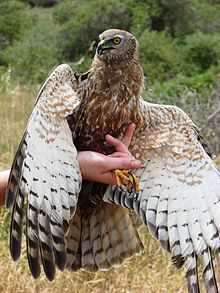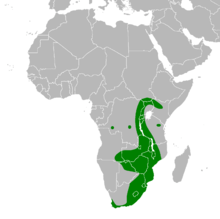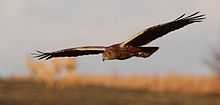African marsh harrier
| African marsh harrier | |
|---|---|
 | |
| Conservation status | |
| Scientific classification | |
| Kingdom: | Animalia |
| Phylum: | Chordata |
| Class: | Aves |
| Order: | Accipitriformes |
| Family: | Accipitridae |
| Genus: | Circus |
| Species: | C. ranivorus |
| Binomial name | |
| Circus ranivorus Daudin, 1800 | |
 | |
The African marsh harrier (Circus ranivorus) is a bird of prey belonging to the harrier genus Circus. It is found in southern, central and eastern Africa from South Africa north to South Sudan with a vagrant record from Nigeria. It is particularly common in the Okavango Delta in Botswana (Simmons 1997). It is usually found in wetland areas, especially those with reeds, but also occurs in grassland and farmland where it forages.

The adult is 44 to 49 cm long, with females being about 30% heavier than males (Simmons and Simmons 2000). Adults, (like the male bird right) have yellow eyes, but brown eyes when immature. Both sexes are mostly brown with pale streaking on the head, breast and forewing and rufous on the thighs and belly. Adult males differ from females in that they have a pale grey wash to the dorsal secondaries and primaries. The female's are brown. The juvenile is dark brown and may have a pale breastband and pale markings on the head. The tail and flight feathers have dark barring at all ages, but this is rarely visible in the juvenile birds. It is usually silent but the male has a high-pitched, two-note display call, and only the female has the far-carrying pseeew-pseeew food and copulation call during breeding.
It feeds largely on small mammals such as the striped mouse Rhabdomys pumilio and also takes birds and frogs and carrion.
Unlike many harriers it is monogamous and remains on the breeding territory for most of the year. In the southern Cape birds leave for a few months post-breeding, returning in May–June. The nest is usually built in a reedbed, sometimes well above the water and two to four white eggs are laid from July to November. All eggs start out with a blue wash allowing newly laid eggs to be identified.
This species as a raptor that relies entirely on wetlands, appears to be in decline over large parts of its range. Wetland drainage is the biggest threat, and one pair requires about 100 ha of wetland (Tarboton & Allan 1984). Where wetlands remain, but are degraded, this species disappears.
References
- ↑ BirdLife International (2013). "Circus ranivorus". IUCN Red List of Threatened Species. Version 2013.2. International Union for Conservation of Nature. Retrieved 26 November 2013.
- BirdLife International (2006) Species factsheet: Circus ranivorus. Downloaded from http://www.birdlife.org on 20/2/2007
- Roger Clarke (1995) The Marsh Harrier, Hamlyn, London.
- Ian Sinclair & Peter Ryan (2003) Birds of Africa south of the Sahara, Struik, Cape Town.
- Simmons R.E. (1997) African Marsh Harrier In: Atlas of Southern African birds Vol 1. Non-passerines. (Eds James Harrison, David Allan, Les Underhill, Marc Herremans, Vincent Parker, Chris Brown) Avian Demography Unit University of Cape Town.
- Simmons R.E. Simmons J.R. (2000). Harriers of the world: their behaviour and ecology. Oxford University Press, UK
- Tarboton W.R. Allan D. (1984) The status and conservation of birds of prey of the Transvaal. Tvl Mus Monographs No. 4. Pretoria South Africa.
External links
- African marsh harrier - Species text in The Atlas of Southern African Birds
